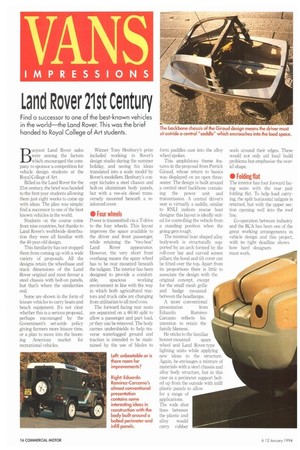Land Raver 21st Century
Page 18

Page 19

If you've noticed an error in this article please click here to report it so we can fix it.
Find a successor to one of the best-known vehicles in the world—the Land Rover. This was the brief handed to Royal College of Art students.
Buoyant Land Rover sales were among the factors which encouraged the company to sponsor a competition for vehicle design students at the Royal College of Art.
Billed as the Land Rover for the 21st century, the brief was handed to the first-year students allowing them just eight weeks to come up with ideas. The plan was simple: find a successor to one of the best known vehicles in the world.
Students on the course come from nine countries, but thanks to Land Rover's worldwide distribution they were all familiar with the 40-year-old design.
This familarity has not stopped them from coming up with a wide variety of proposals All the designs retain the wheelbase and track dimensions of the Land Rover original and most favour a steel chassis with bolt-on panels, but that's where the similarities end.
Some are shown in the form of leisure vehicles to carry boats and beach equipment. It's not clear whether this is a serious proposal, perhaps encouraged by the Government's set-aside policy giving farmers more leisure time, or a plan to move into the booming American market for recreational vehicles. Winner Tony Henbury's prize included working in Rover's design studio during the summer holiday, and seeing his ideas translated into a scale model by Rover's modellers. Henbury's concept includes a steel chassis and bolt-on aluminium body panels, but with a vee-six diesel transversely mounted beneath a reinforced cover.
• Four wheels
Power is transmitted via a T-drive to the four wheels. This layout improves the space available to the driver and front passenger, while retaining the "two-box" Land Rover appearance. However, the very short front overhang means the spare wheel has to be rear mounted beneath the tailgate. The interior has been designed to provide a comfort able, spacious working environment in line with the way in which both agricultural tractors and truck cabs are changing from utilitarian to all mod cons.
The forward facing rear seats are separated on a 60/40 split to allow a passenger and part load, or they can be removed. The body carries undershields to help traverse waterlogged ground and traction is intended to be maintained by the use of blades to form paddles cast into the alloy wheel spokes.
This amphibious theme features in the proposal from Patrick Giraud, whose return to basics was displayed on an open threeseater. The design is built around a central steel backbone containing the power unit and transmission. A central driver's seat is virtually a saddle, similar to RNLI inshore rescue boat designs: this layout is ideally suited for controlling the vehicle from a standing position when the going gets rough.
The minimal boat shaped alloy bodywork is structurally supported by an arch formed by the roll-over bar and curved screen pillars; the hood and tilt cover can be fitted over the top. Apart from its proportions there is little to associate the design with the original concept, except for the small mesh grille and badge mounted between the headlamps.
A more conventional presentation from Eduardo Ramirez Carcarno reflects his intention to retain the family likeness.
He sticks to the familiar bonnet-mounted spare wheel and Land Rover-type lighting units while applying new ideas to the structure. Again, he envisages a mixture of materials with a steel chassis and alloy body structure, but in this case as a perimeter support bolted up from the outside with infill plastic panels to allow for a range of applications. The wide shut lines between the plastic and alloy would carry rubber seals around their edges. These would not only aid local build problems but emphasise the overall shape.
• Folding flat
The interior has four forward facing seats with the rear pair folding flat. To help load carrying, the split horizontal tailgate is retained, but with the upper section opening well into the roof line.
Co-operation between industry and the RCA has been one of the great working arrangements in vehicle design and this project, with its tight deadline shows how hard designers must work.
Although Land Rover's success in world markets has been achieved by evolutionary rather than revolutionary design policy, the market is gently changing.
Ten years ago more than 80% of the output went to Third World countries—today nearly 90% is sold in Western markets. This reflects the shift from the utility Defender to the sporeutility Range Rover and Discovery On this time scale, it is very wise for them to consider the requirements of the appmaching 21st century
by Brian Hatton








































































